Our five recommendations to CO2 Standards for trucks and buses trilogue negotiators
CO2 Standards for HDVs
Our recommendations to trilogue negotiators
The members of the Platform for Electromobility welcome the position adopted in November by the European Parliament on the revision of the CO2 Standards for trucks and buses Regulation. Welcomed overall, the text provides a robust and ambitious yet realistic and business-friendly path toward decarbonisation of road transport in Europe. Ahead of trilogue negotiations, we hereby highlight key elements that negotiators should keep in mind to safeguard the Regulation’s added value
| 1 |
First and foremost, we urge negotiators to reach a conclusion before March 2024 to avoid losing one year in our collective fight against climate change. Considering the deadline of the text, a late agreement would delay its application by a full year, hence jeopardising our joint effort to reduce CO2 emissions and reach net-zero society in 2050. A timely resolution is paramount to providing certainty to the truck and bus industries, its customers as well as adjacent infrastructures and energy industries, enabling them to plan and invest in the necessary innovations for compliance.
| 2 |
Industrial certainty and environmental progress are also jeopardised by a potential loophole that could open the way for unrealistic use and expectation of e-fuels and biofuels. Both alternative fuels solutions are inherently inefficient[1] and should remain out of the CO2 standards. Renewable and low carbon fuels and, most notably, e-fuels will not be carbon-neutral in time to decarbonize the road transport sector and meet our climate targets, and as a result should be limited where direct electrification is not feasible, namely in maritime and aviation sectors. These fuels are scarce resources sorely needed to reduce greenhouse gas emissions in the aviation and shipping sectors, whereas the road transport sector is well-suited for electrification. They do not provide a viable alternative to existing zero-emission solutions. In addition, e-fuels aren’t currently produced at commercial volumes. Scaling up additional renewables, electrolysers, direct air capture (DAC) and e-fuel production facilities would take time and larger e-fuel quantities would likely not be available before 2040.
| 3 |
Thirdly, considering that in 2022 30% of new buses in Europe were already zero emission, an urged confirmation of the 100% Zero Emission mandate target at 2030 for urban buses, with no postponements, is an optimal option, notably with the move of the two subcategories of urban buses, namely class II low-entry (i.e. 31L2 and 33L2) into the coach segment, as they are often used by local and regional authorities for longer distance public transportation. While reducing the CO2 emissions of those groups of vehicles, this choice would also bring substantial public health benefits by lowering the amount of particulate matters (PM) emitted.
| 4 |
Fourthly, we praise the European Parliament’s extension of the emission debts and crediting system from 2030 to 2040 gives additional flexibility to manufacturers to earn credits (when reducing emissions more than required) and use them to offset debts (if emissions are above what is required). Credits now can be used for 15 years to offset debts. Credit’s lifetime should have a maximum of 5 years as do the debts. This would force manufacturers to continuously invest in reducing their CO2 emissions. This mechanism is pivotal in encouraging industry players to adopt sustainable practices and contribute meaningfully to the reduction of greenhouse gas emissions.
| 5 |
Platform members also recognise the positive impact a fleet mandate mechanism would have on the decarbonation of heavy-duty vehicles. On this point, Platform members equally stress the importance of support mechanisms for the rollout of office-based charging, from subsidies to tax discounts.
With a timely conclusion, unequivocal standards without place for questionable alternative fuels, the strongest ambition on decarbonization of urban buses, an ambitious definition of zero-emission heavy-duty vehicles and fit-for-purpose emission debts and crediting system, the CO2 Standards for trucks and buses would truly be the regulatory framework that promotes sustainability, innovation, and the accelerated adoption of zero-emissions road transport.
[1] Estimates indicate that the electricity requirements for the production, transportation, and distribution of various e-fuel types are significantly higher, ranging from approximately 1.6-1.8 times greater for compressed gaseous hydrogen to between 2.2 and 6.7 times higher for liquid e-fuels, in comparison to the direct use of electricity, depending on the specific fuel type. When we account for not just the fuel production phase but also the efficiency losses within the vehicle powertrain during e-fuel usage, the overall efficiency diminishes even further.
Recommendations for the deployment of sustainable infrastructure of BE HDVs
Logistics & Infrastructures
Driving the adoption of Battery Electric Heavy-Duty Vehicles
General policy recommendations for the deployment of sustainable infrastructure
The members of the Platform for electromobility recognise the importance of driving uptake of the required infrastructures for Battery Electric Trucks and buses (BEHDVs). They also recognise the need for policy recommendations that complement the Alternative Fuels Infrastructure Regulation (AFIR) and Energy Performance of Buildings Directive (EPBD).
The challenges in this area span multiple sectors, from energy, through land management and on to data security. We therefore emphasise the importance of cooperation between all sectors of the electric road transport system, resulting in this paper, which outlines the key elements that legislators should keep in mind when addressing this topic.
In this position paper, we identify three areas that require attention and provide policy recommendations to ensure the successful roll out of infrastructures for BEHDVs: the grid, the data framework and the land.
Beyond infrastructure (which this paper is dedicated to), we stress the importance of ambitious, clear and timely revision of both the CO2 Standards for trucks and buses Regulation and the Weights and Dimensions Directive. We have discussed both of these in previous publications (respectively here and here).
The grid

A. Assessments: per country and per usage
While strong CO2 Standards would prove useful for anticipating actual and future demand, a situation where a grid connection may not be available can potentially undermine the trajectory defined by those new CO2 Standards. It therefore becomes urgent to immediately and proactively assess whether there is sufficient potential grid-capacity to allow for sufficient connection for the charging infrastructure needed for BEHDVs. Assessment becomes all the more pressing when considering the lengthy lead times, the need for grid reinforcement, the likely demand for BEHDVs and the number of actors involved.
Grid infrastructure varies between countries. Some may need important investments in order to prepare for the integration of BEHDVs, with the development of megafast chargers where required. In the Netherlands – a European Member State at the forefront of road transport electrification (along with other such as Germany and, to a lesser extent, Belgium) – it appears to be extremely difficult for transport operators to obtain the needed capacity for BEHDVs, both at their depots and on the road, due to a lack of effective planning. Even where capacity increases are possible, long delays for connection and procedural constraints present barriers to the swift adoption of BEHDVs.
Grid infrastructure varies between usages. While large charging hubs for BEHDVs along motorways will be the exception and the depot/destination charging overnight the rule, the need for very high-level connection capacity along the motorway should be tackled. Medium- and high-voltage connections to the power grid will be necessary to support the fast charging times in the event of opportunity charging. To deliver the necessary power capacity, grid strengthening may be required at both public locations and – for different reasons – at private charging depots/distribution centres.
BEHDVs-suitable charging locations can be mapped and the power needs for those locations assessed. Recent existing mapping[1] – based on the GPS records of large numbers of trucks routes during one year throughout Europe – can provide a good starting point. Truck stakeholders can subsequently confirm or propose new locations for the recharging infrastructure and the power required. Distribution System Operators (DSOs) and Transmission System Operators (TSOs) should confirm whether there is sufficient capacity and, where necessary, propose alternatives.
We would welcome support for undertaking a similar mapping exercise for coaches and interurban buses. Such analysis would also support the task forces (see below) in deciding the pre-equipment needed for depots and distribution centres, as well for existing service stations. This would ensure that delays in installing charging stations for BEHDVs do not exceed reasonable timescales.
Mapping analysis shows some 10% of locations will account for half the opportunity charging stops.[2] Pre-identifying these would help accelerate the coordinated development of charging infrastructure for BEHDVs and facilitate discussion within the dedicated task forces.
B. Task Forces
The task forces – constituted as follows – should be established and moderated by transport ministries or designated government agencies. National task forces: DSOs or their representations; TSOs; manufacturers of BEHDVs, BEHDVs operators and national associations[3]; representations of energy aggregators operators; fleet managers; road and urban planners; national Charging Point Operator (CPOs) associations.
Such task forces would be well suited for indicating the investments required to extend and reinforce charging infrastructure and to determine suitable charging locations and power requirements. This will enable DSOs and TSOs to plan the necessary grid extensions and reinforcements. This is extremely important for those areas that are not being developed by project developers due to high investment costs and long lead times for grid connections. The bottom line for achieving a comprehensive approach to planning involves early engagement with fleet managers, road operators, local municipalities, CPOs and grid utilities. Such an approach helps in proactively addressing public acceptance, potential land use challenges and in establishing a workable and timely power delivery schedule.
C. National deployment plans
In order to forge a stronger link between the AFIR implementation and the deployment of charging infrastructure for BEHDVs, we propose that Member States base their own national deployment plans on the AFIR targets, reflecting the anticipated demand at each location.
These plans should align with the anticipated demand for BEHDV charging, while also considering such factors as traffic density and projected growth in BEHDV usage and stops. By adopting such an approach, Member States can provide network operators and other stakeholders with longer lead times for planning future infrastructure uptake and anticipated connection requests, particularly post-2030.
D. Public & private investments
A high-capacity grid does not come without costs. Ultrafast charging stations are expected to require large MVA network connections, which usually occur directly at high voltage level but can also occur at MV level, depending on Member State specificities.
Well-designed European financing programmes can attract private investments for BEHDV infrastructure development. To facilitate implementation, and considering the high CapEx involved, public funding should be made available: The Connecting European Facility (CEF) is a vast programme, one that is primarily focused on passenger cars rather than on BEHDVs. This limits its alignment with the needs of the heavy-duty vehicle sector. Typically, the Alternative Fuels Infrastructure Facility (AFIF) Call of the CEF Programme supports BEHDVs infrastructure between 150kW and 350kW while for 800kW and higher, power the financial solutions provided by European Commission are too limited. The annex should be adapted to better take account of the needs of BEHDVs.
2. The Data Framework

A. Align grid codes, regulations to ultrahigh-power charging standards under development
The introduction of ultrahigh power charging standards necessitates global and European recognition. When being designed, standards should take into account factors such as space and interoperability as well as the futureproofing of those ultrahigh power charging standards currently under development. Any existing regulations that did not anticipate BEHDVs and their charging infrastructure must be updated to in order to accommodate this new paradigm. Definitions of technical aspects and use cases must be integrated into existing technical codes and regulations. Temporary exceptions will likely be required in areas such as standardised and certified energy metering concepts, which are currently lacking for megawatt charging. Member States should implement standards for BEHDV infrastructures for both public and private applications. Last, it is not possible to apply to EU funding for deployment of standards that have yet to be adopted.
B. Harness the flexibility potential of BEHDVs
Smart and bidirectional charging can be key in increasing the uptake of renewable energy and in offering flexibility potential to the grid. While initially this may seem challenging to implement, given the fast-charging requirements dictated by the road transport business model based on opportunity charging. Yet, the potential to harness the flexibility of the BEHDVs is actually significant, particularly considering their battery sizes, the high predictability of their routes and time schedules and the predominance of depot/overnight charging.
Smart energy management systems can therefore be deployed, specifically through the implementation of balancing mechanisms between connectors. This will synchronise with renewable energy production and provide a fast-frequency response to keep the grid stable. This would further require signals to use the flexibility from batteries, such as incentives for aggregators and dynamic tariffs, etc. Beyond advanced planning, tariffication incentives and financial incentives in the grid services markets are other crucial elements for minimising grid impact and allowing potential grid balancing.
Bidirectional and smart charging can be particularly suitable for certain business models, notably buses and trucks that are not operated on a 24/7 basis (short-haul and regional transport). Their large batteries can offer key services to the grid. Smart meters should be considered as one of the solutions for smart charging in depots and distribution centres. However, regulatory frameworks will need to be adapted in order to enable bidirectional charging and provide economic incentives.
Finally, the sector is currently exploring the potential of flexible storage positions within local energy systems, such as incorporating stationary batteries into charging stations or exploring battery swapping solutions. Such approaches can help reduce the strain on the grid, offering advantages to both charging operators and system operators by enhancing flexibility. In addition, configurations integrating renewable energy sources on site should be examined for smart charging, as they have the potential to mitigate expected peak loads.
C. Data sharing for smooth logistic operations
A proper regulatory framework would also enable data and information exchange along with digitalisation for cross-sector integration:
Smooth reservation and non-discriminatory access to, and reliable operation of, public recharging infrastructure can accelerate the transition to BEHDVs. Standardised data sharing and interoperability between value chain players are a prerequisite for third-party operators of smart charging services and for the proper functioning of smart charging technologies.
Currently, however, data sharing and interoperability are often limited, which can lead to inefficiencies and reliability challenges. For example, charging point operators may not have access to real-time data on the location and battery state of charge of heavy-duty trucks. This in turn can make it challenging to plan optimal power needs and manage the charging process. Likewise, logistics operators may not have access to real-time data on the availability of charging infrastructure, which can lead to delays in delivering goods. There are multiple data types for multiple use cases that require a minimum of data sharing across the industry to enable efficient logistics and reliable charging.
Agreeing minimum specific list of data points for BEHDVs, interoperability standards and developing a robust, open and non-discriminatory data sharing framework will allow logistics operators, truck manufacturers, grid and charging point operators to put solutions in place for improving the reliability and efficiency of logistics operations and recharging infrastructure.[1] The European Commission should support the parties involved, with the aim of establishing an open data-sharing framework built around a set of industry-agreed data types, made accessible to the market and public authorities. Ultimately, it should strive to establish a reliable European legal framework for smooth data exchange for electric HDV recharging operations throughout the EU.
D. Understand the charging patterns
Last, further research is required to understand the charging patterns and to demonstrate the cost opportunities for transport operators and Mobility Service Providers (MSPs) of participating in the flexibility services market. TSOs – in collaboration with fleet operators – can play a crucial role, for example by introducing pilot projects and regulatory sandboxes to gather experience on grid impacts and reactions to time-varying tariffs, and to eventually assess the real flexibility potential.
The Land

A. Quantity: Sufficient space for trucks and buses public and private charging
According to the European Commission[1], there is a shortage of around 100,000 suitable parking spaces for HDVs, of which only around 54,000 offer a reasonable standard of safety. We can therefore no longer ignore the shortage of parking space for truck drivers. This current lack of parking leads to improperly parked trucks, leading to both environmental and safety issues for truck drivers and other road users and places a considerable burden on truck drivers. Even existing parking areas frequently lack adequate facilities or are in a state of disrepair.
The need for additional charging infrastructure created by the advent of electrification makes these issues even more acute. Consequently, the availability of ample parking space – now in parallel with charging facilities – represents more than a mere convenience; rather, it is an indispensable prerequisite for driving the transition to a decarbonised transport system.
B. Quality: Safe and Secure Truck Parking Areas (SSTPAs) suited to charging
Private investment in constructing increasingly costly infrastructure such as large-scale parking facilities, warrants reinforcement through European and national public funding initiatives. Such incentives include grants, tax benefits and subsidies geared to attracting private investment in the construction of parking areas with integrated charging stations for BEHDVs. Such moves can help offset initial infrastructure costs and incentivise the expansion of such facilities. While establishing more ambitious – yet attainable – targets for each Member State at an EU level emerges as a sensible strategy, the reality of achieving these minimum standards is frequently faced with lack of available land, particularly in densely populated areas. To overcome this challenge, the EU should support Member States in pursuing following options:
- Earmarking publicly owned land for investors to develop new parking and charging spaces. Alternatively, streamlining the permitting process and alleviating bureaucratic complexities to incentivise private investments in additional parking capacity.
- Enhancing the synergy between private landowners and operators of parking and charging spaces through improved matchmaking mechanisms and by leveraging digital platforms.
- Tendering (greenfield) locations where investors are hesitant via a ‘concession model‘, eventually combined with incentivised deployment on certain locations. In a concession model, governments can accelerate permitting and realisation of grid connections.
- Cooperating with system operators to secure grid capacity on shared (or tendered) locations.
C. Must-have for market models
Other market models (land sale, rental, long lease) are viable alternatives, but lead to more commitment in implementation (profitable business case, cooperation, multiple operators on one site). All market models should consider monopoly on ‘premium’ sites, market forces in designated locations, differences between HDV and LDV infrastructure markets and maximising market forces.
D. The role of concession holder
In essence, the role of concession holder can play an ever-more prominent role in accelerating the market by:
- Taking the lead in all restrictive conditions (such as grid connection, land ownership)
- Securing grid capacity before locations are offered for tender. Participate with system operators to secure grid capacity on multisite (multiple operators using a single grid connection). Facilitate consortia to own and initiate a shared site with multiple operators of zero emission infrastructure.
- Acting as a bridge function in sharing construction and basic infrastructure costs when multiple operators settle on a site (such as direction on site layout, site paving).
- Promoting a location for charging infrastructure operators by attracting other services (retail, hospitality, etc).
The Grid [1] https://www.acea.auto/press-release/electric-trucks-new-data-maps-out-priority-locations-for-charging-points/ [2] https://www.isi.fraunhofer.de/content/dam/isi/dokumente/cce/2021/ACEA_truckstop_report_update.pdf [3] Shippers and carriers such as TLN in the Netherlands or RHA in the United Kingdom. The Data Framework [1] Smart charging, BET eRoaming, Plug and Charge, Value Added Services (i.e., Preconditioning), flexibility provision services in relation to battery degradation patterns etc. The Land [1] https://www.iru.org/system/files/Final-Report-SSTPA-27022019.pdf
CO2 Standards for HDVs : Our warning against inclusion of Carbon Correction Factor
Platform for electromobility warns against the inclusion of renewable and low-carbon fuels and a carbon correction factor in the CO2 Standards for trucks and buses
Ahead of the vote on the CO2 Standards for trucks and buses Regulation in Plenary of the European Parliament on the 21st November, the members of the Platform for electromobility would like to express their deep concern regarding the potential introduction of low-carbon fuels (advanced biofuels), synthetically produced fuels (e-fuels) and a Carbon Correction Factor (CCF) to account for them, in the CO2 Standards for Heavy-Duty Vehicles (HDVs). We urge you to carefully consider the implications of such a measure and, in the best interests of our regulatory framework and environmental goals, reject its introduction unequivocally.
Opening the door to these fuels into the revisions of the CO2 Standards poses significant challenges. The introduction of a Carbon Correction Factor (CCF) to account for them would be equivalent in lowering the average specific emissions of a certain manufacturer, as per the Impact Assessment of the EC[1]. Since the Renewable Energy Directive – REDIII already rewards the use of low-carbon fuels like bioethanol, bio-methane or synthetic fuels produced from renewable electricity, with the strongest possible economic incentives by setting sales mandates for the deployment of such low-carbon fuels across all sectors, including freight transport, this would mix well-to-tank (fuels and electricity from RED) and tank-to-wheel (vehicle tailpipe emissions from CO2 standards) regulation, leading to potentially regulatory inconsistencies and, at its worst, result in unenforceable legislation. This would blur the roles and responsibilities of different market participants, even though this regulation primarily applies to vehicle manufacturers, potentially constituting double counting, as highlighted by NGOs[2] and studies[3]
Moreover, beyond the immediate concern of CO2 emissions, the introduction of a CCF could adversely impact air quality, especially in urban areas. Allowing last-mile delivery trucks to emit more pollutants in cities could contradict existing legislation, such as the Air Quality Directive, which was recently adopted in the European Parliament. The directive aims to achieve improved air quality, particularly in cities, by 2030, aligning with the World Health Organization (WHO) standards and ultimately striving for zero pollution by 2050. Lowering the ambition of the CO2 standards for HDVs would run counter to these efforts to enhance air quality.
We understand that there has been debate regarding the competitive advantages of e-fuels compared to battery-electric technologies. However, it is important to note that battery-electric technologies can already satisfy almost all of European freight road transport needs, a share that will likely increase with the growth of intermodal logistical systems.
Furthermore, we emphasize the inherent inefficiency of e-fuels. Renewable and low carbon fuels and, most notably, e-fuels will not be carbon-neutral in time to decarbonize the road transport sector and meet our climate targets. It is worth noting that these fuels are scarce resources sorely needed to reduce greenhouse gas emissions in the aviation and shipping sectors, whereas the road transport sector can easily be electrified. As a result, e-fuels do not provide a viable alternative to existing zero-emission solutions. Estimates indicate that the electricity requirements for the production, transportation, and distribution of various e-fuel types are significantly higher, ranging from approximately 1.6-1.8 times greater for compressed gaseous hydrogen to between 2.2 and 6.7 times higher for liquid e-fuels, in comparison to the direct use of electricity, depending on the specific fuel type. When we account for not just the fuel production phase but also the efficiency losses within the vehicle powertrain during e-fuel usage, the overall efficiency diminishes even further. In addition, E-fuels aren’t currently produced at commercial volumes[4]. Scaling up additional renewables, electrolysers, direct air capture (DAC) and e-fuel production facilities would take time and larger e-fuel quantities would likely not be available before 2040.[5]
In conclusion, we urge Members of the European Parliament to carefully consider the potential ramifications of introducing a Carbon Correction Factor in CO2 Standards for Heavy-Duty Vehicles, as it would not bear significant results, while setting a dangerous precedent and creating great uncertainty for European truck manufacturers. We believe that maintaining a clear and consistent regulatory framework, along with our commitment to improving air quality, should guide our decisions in this matter. We appreciate your attention to this critical issue and look forward to further discussions.
In addition, we would like to remind the key recommendations from previously published position:
- keep the ambition of the CO2 emission reduction targets (final and intermediate), to fully decarbonize the sector by 2050, at least as per EC proposal;
- The proposed 2030 target of -45% is lacking ambition and is below what manufacturers have announced. It should be increased to an emission reduction level of at least 65%.
- The proposal’s new definition of zero emission (5 gCO2/tkm) creates a dangerous loophole for continuous sales of emitting vehicles even after 2050. The Platform strongly advocates to keep it as it is (1 gCO2/kWh).
- Keep the 100% ZEV mandate target at 2030 for urban buses, including an intermediary target with a 70% ZEV mandate by 2027 . Two subcategories of urban buses, namely class II low-entry (i.e. 31L2 and 33L2), should be moved into the coach segment.
[1] compared to the medium ambition scenario (TL Med), the average CO2 emissions per tkm of the new vehicles fleet of this option increases by around 13% in 2030 and leads also to a higher uptake of ICEV instead of ZE ones. All in all, the CO2 tailpipe emissions during the period 2031-2050 increase by about 8% of the cumulative emissions in TL_Med. In addition, food- and crop-based biofuels are associated with significant indirect climate emissions, causing higher GHGs than their fossil counterpart (ICCT, 2017 link) and e-fuels, would not be able to reduce air pollutant emissions in any meaningful way (T&E 2021 link). [2] “A carbon correction factor for trucks? Don’t be fooled by the oil industry’s latest con “ Transport & Environment. October 12th 2023. Link. [3] ICCT 2018 Decarbonization potential of electrofuels in the European union [4] Production sites, including experimental facilities are 18 at the moment. E-Fuel Alliance. link [5] Odenweller et al. (2022). Probabilistic feasibility space of scaling up green hydrogen supply. Link.
Weights and Dimensions Directive: How to accelerate the uptake of zero-emission heavy-duty vehicles
Review of the Weights and Dimensions (W&D) Directive:
How to accelerate the uptake of zero-emission heavy-duty vehicles
In July 2023, the European Commission published the Greening Freight Package with the purpose of making freight more sustainable and efficient. As part of this Package, the review of the Weights and Dimensions (W&D) Directive aims to promote the uptake of electric and hydrogen trucks and buses.
The Commission proposes to increase the weight and length limits of zero-emission (ZE) heavy-duty vehicles. These provisions are intended to ensure ZE trucks don’t have to sacrifice cargo weight on long-haul routes, and ZE buses don’t have to decrease the number of passengers, in comparison to a comparable combustion model. However, the proposal fails to ensure the full application of the ZE weight allowance.
Despite noble intentions, the Commission includes several provisions which would keep the EU anchored to diesel trucks. In particular, the proposals on gigaliners[1] and combustion vehicles of 44 tonnes risk steering investment away from the zero-emission sector. Furthermore, the review should pay more attention to road wear and bridges.
The proposal also needs changes to make it truly intermodal and interoperable with other modes like (electric) rail. Such changes cannot be designed without having a perspective on what the Combined Transport Directive (CTD) will look like. This Directive plays an important role in reducing the carbon footprint of the whole logistic sector. For this reason, and as detailed in the Platform’s recent letter, we ask the European Commission to present the CTD without further delay. As such both proposals can be truly treated “as a package”, as was originally intended.
The need for a review of the W&D Directive
The heavy-duty vehicle (HDV) sector needs to decarbonize rapidly. In the first half of 2023, diesel trucks accounted for 95.6% of newly registered trucks[2]. While trucks account for just 2% of vehicles on the road, they are responsible for nearly 30% of greenhouse gas emissions from road transport in Europe.
Under current policies, this share is set to grow. According to the European Commission, truck activity will increase by about 40% between 2019 and 2050. Over the same period, bus and coach activity is expected to grow to a smaller but still considerable extent (+10%). Although buses are decarbonising much faster – 30% of new urban bus sales in 2022 were ZE – diesel buses still represented 67.3% of the new sales in Europe in 2022[3].
The EU thus needs to rapidly transition to 100% zero-emission HDV sales. As ZE trucks and buses weigh more than their diesel counterparts, a review of the W&D Directive is needed to really incentivise their uptake and set the sector in line with the Union’s goal of climate neutrality by 2050.
Our shared vision
We welcome the Commission’s intention to give zero-emission trucks a 4t weight allowance (as well as 2t to ZE buses). However, co-legislators need to intervene and ensure zero-emission trucks can fully use it, so that it is ensured that under no use case long-haul ZE trucks, which require bigger batteries, would have to sacrifice cargo weight. The proposal severely hampers the application of the ZE allowance, leaving road freight across key national borders (e.g. between France and Belgium) largely to diesel trucks.
The Commission requires the use of the ZE weight allowance for cross-border movement only, underestimating the relevance of national transport. Also, the wording of the Annex risks giving the 4t ZE allowance to diesel tractor units only because they pull electric trailers.
An increase in driving axle weight is essential for long-established truck-makers to switch from making fossil vehicles to electric. However, truck-makers don’t need the proposed 1t increase (from current 11.5 to 12.5t), which also fails to incentivise them to switch to clean sheet designs (lighter, optimised e-trucks).
The proposed regularisation of the cross-border movement of 44t combustion vehicles and of European Modular Systems (so-called gigaliners) brings them out of their current legal grey area. These longer, heavier vehicles will however only achieve real emission reductions if they are zero-emission. Unfortunately, the Commission does not provide any sunset clause for the cross-border movement of fossil gigaliners, nor does it propose a ZE weight allowance for these vehicles, thereby offering no incentive for the use of ZE gigaliners by fleet operators. Extending the use of 44t combustion vehicles and gigaliners risks delaying the take-up of electric vehicles, particularly during the 2020s. Making internal combustion trucks more attractive for long-haul transport also increases the fossil fuel dependency of the European freight sector, and therefore the EU’s dependence on imports.
Intermodal logistics system
Enhancing intermodal logistics in Europe is crucial to reach CO2 reduction objectives. Intermodal compatibility must be ensured throughout the revision process of the W&D Directive (which should not penalise rail freight) and the upcoming Combined Transport Directive.
Therefore, the Platform supports prior assessment for new gigaliner routes / movements so that they do not take traffic from rail or waterway. This prior assessment should also include an analysis of road safety and the need for additional driver training. As Kristian Schmidt, DG MOVE’s land transport director, has noted, reform should not promote truck traffic at the expense of rail, or “we’re in all kinds of political trouble[4].”
The Commission proposes +4t for zero-emission trucks, but fails to ensure its full application. Because of the 44t weight limit, ZE trucks heavier than >40t cannot fully use it (without losing payload). This de facto decreases the ZE incentive. Our recommendation would fully keep it.
The proposal only requires the use of the 4t ZE allowance for cross-border movement. Given the relevance of national freight, it should also be applied within each Member State. Also, co-legislators need to make sure that diesel tractor units just pulling e-trailers do not receive the ZE allowance.
The Commission proposal (1t increase from 11.5 to 12.5t) would increase road wear by ~40%[5]. We propose limiting the increase to 12t, which is enough for manufacturers, and make it conditional on safeguards related to tyres, tyre pressure monitoring and acceleration[6]. The 2029 sunset clause for trucks[7] will incentivise the use of 3-axle tractor units and clean sheet designs (lighter vehicles).
Zero-emission / intermodal gigaliners should be guaranteed the 4t ZE allowance proposed for other vehicle combinations. As well as the 2030 phase-out for diesel, conditionality should cover a prior assessment to avoid reverse modal shift from rail, and analysis for road safety & driving training.
5-axle rigids are short vehicles (max 12m). Currently, their cross-border movement is limited to 32t. The proposal (40t +2t ZE allowance) would damage roads and bridges whereas the recommendation here makes any increase subject to the application of a 2t ZE allowance.
The Platform for electromobility called, in an open letter to Commissioner Valean to urgently present the Combined Transport Directive revision. Read the letter here: https://www.platformelectromobility.eu/wp-content/uploads/2023/11/PfEM_Open-Letter-to-Commissioner-Valean-on-Combined-Transport-Directive.pdf
in order to guarantee a swift (1 year) transposition of rules and enable a rapid upscale of battery-electric trucks in the EU.
[1] Longer and heavier vehicle combination consisting of more modules and with a typical length of 25,25m. [2] ACEA (2023). New commercial vehicle registrations: vans +11.2%, trucks +20%, buses +15% in the first half of 2023. Link. [3] This share decreased to 63% in the first half of 2023. [4] Politico, 29 September 2023. [5] UK Department for Transport (2010). HGV maximum weights. Link. [6] More specifically, wide-base high-efficiency single tyres on the steering axle and a dual tyre configuration on the driving axle; the alert threshold of the Tyre Pressure Monitoring system set at 0.6 bar, rather than current 1.2 bar, with a duty to restore under- or over-inflation at the nearest available facility; an acceleration limiter, with 1.2 m/s2 as a limit. [7] An indicative phase-out date of 2035 should be set for ZE buses.
CO2 Standards for trucks and buses: our reaction
Recommendation paper of the Platform on the revision of the HDV CO2 emission standards following the Commission’s proposal
The Platform for electromobility very much welcomes the proposal by the European Commission for revision of the CO2 standards for heavy-duty vehicles (HDV) and sees the regulation as a fundamental tool to electrify trucks and buses and thus advance the rapid roll out of zero emission vehicles (ZEV) in the road heavy transport sector. Currently, trucks and buses together make about 27% of the EU road transport emissions and trucks make up more than three quarters those. The proposal of the Commission for the revision of HDV CO2 standards falls short to align the CO2 targets for the sector with the EU’s overall -55% GHG reduction target in 2030 and the climate neutrality target of 2050.
In order to transition the road freight sector to zero emission, more ambitious standards are needed to set the right pace and a clear trajectory for manufacturers, logistics operators as well as for the supply chains in the electromobility and automotive industry. Scaling effects in production and technology development in the e-mobility and transport sector contribute to making electric HDVs more competitive and widespread.
Uniting ambitious green supply-side policy making with investments into cleantech industries, as done with the Net Zero Industrial Act, allows Europe to remain a climate leader whilst paving the way for thriving industries. The Platform calls on the European Parliament and Member States to notably strengthen the targets of the HDV CO2 standards, reducing emission, air pollution levels and setting pace for a greening road transport sector.
Almost all newly registered trucks should be 100% zero emission at the latest by 2035, including small, medium and large trucks considering the average lifespan of a truck of roughly 15 years. Non-regulated vehicles, such as vocational vehicles, should be put on a track to zero-emission by 2040 with the help of a ZEV mandate. Small trucks between 3.5-5t are possible to decarbonize within a few years as truck models are available and they can be operated without hurdles already today. These trucks are currently not part of the scope and should be included with a 100% ZEV mandate by 2030.
The Act should consider the demand for strategic raw materials across all e-mobility sectors. Batteries are of critical importance for the success of the EU Green Deal. The competitive environment in which battery manufacturers operate has evolved significantly since the first EU Battery Action Plan was developed in 2018. The Act offers the opportunity to update the EU Battery Action Plan and articulate the steps that Europe should take to support battery roll out.
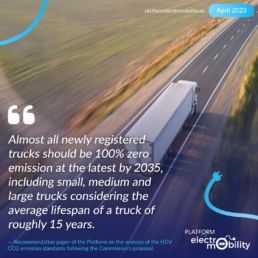
The proposal’s new definition of zero emission (5 gCO2/tkm) creates a dangerous loophole for continuous sales of emitting vehicles even after 2050. The current definition requires trucks to emit less than 1 gCO2/kWh. The change of definition in the proposal allows for dual-fuel trucks running on 10% polluting diesel to be called zero-emission. The Platform strongly advocates to further only truly clean and future proof technologies and reverse the definition of ‘zero-emission’, and asks to keep it as it is (1 gCO2/kWh)

Sourcing should be both adequate and sustainable. The legislation should focus on ensuring an availability of supply that respects both human rights and environmental standards, regardless of the country of origin.
The global CO2 emission reduction targets for lorries as well as coaches should be significantly increased to align it with Europe’s 2030 climate target and market feasibility considering the sales targets by heady duty vehicle makers of up to 63% zero emission by 2030 . The proposed 2030 target of -45% is lacking ambition and is below what manufacturers have announced. It should be increased to an emission reduction level of at least 65%. An ambitious early target is key to breaking the cost barriers by unlocking rapidly improving battery technologies and by profiting from efficiency gains of ZEV series production.
The platform very much welcomes energy efficiency targets for trailers and semi- trailers as they will be a catalyst and accelerator for additional emission reductions.
An intermediary target should be included with a 70% ZEV mandate by 2027 considering that in 2022 30% of new buses in Europe were already zero emission , allowing city buses to move on a faster emission-free trajectory. As the bus target is counted towards the global CO2 emission reduction target, manufacturers have additional flexibility to reduce their emission by producing ZEVs in either of the categories – buses or coaches.
Two subcategories of urban buses, namely class II low-entry (i.e. 31L2 and 33L2), should be moved into the coach segment, as they are often used by local and regional authorities for longer distance public transportation. A usage that will be more difficult to decarbonize by 2030. In parallel, coaches, therefore including class II low-entry, should have the following CO2 reduction targets: 20% ZEVs by 2027, 60% by 2030 and 100% by 2035.
Policy makers need to create enabling conditions for transport operators and local and regional public authorities to transition to zero emission, such as sufficient funding opportunities for buses and infrastructure as well as assured grid reinforcements. In cases where recent investments into low-emission infrastructure have been made, an extended deployment of the existing bus fleets beyond their average lifetime can be made.
More clarity on the exemptions introduced by Article 3.b. would be needed as the content of the upcoming Delegated Act are not known yet and give the exemption a high level of unpredictability. The “maximum share of vehicles that a Member State can exclude” should be limited to the maximum level that does not jeopardize the strength and very meaning of the target. In addition, MS should strongly and objectively demonstrate and motivate the reasons for asking for the exclusions.
In order to help city councils and operators lower the cost of bus electrification, the best price-quality ratio criteria in the new public procurement procedures (article 3c) should include not only the provision of buses but also other services as the installation of the depots and on-road charging infrastructure and their operation and maintenance.
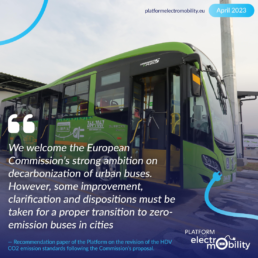
• The platform supports the Commission’s decision not to include a crediting mechanism for renewable and low-carbon fuels under this regulation. Under such a mechanism, manufacturers could continue to produce ICE vehicles and delay the transition to zero emission ones whilst not actually being able to control how fuels are being used in the end (and still being rewarded for it). In addition, incentivising these fuels are incompatible with EU efforts to increase efficiency and reduce energy consumption in HDVs.
• The ZLEV mechanism should be transformed into a ZEV only mechanism and as proposed phased out by 2030 when significant market ramp-up for zero emission trucks and buses can be expected.
• The possibility of transferring of zero-emission vehicles between non-connected manufacturers should be maintained. However, in order to create a large-enough market place for trading between manufacturers, co-legislators should remove the proposed 5% cap for receiving manufacturers.
• There should not be an exemption for small volume manufacturers as it is a contrary measure to reach carbon neutrality by 2050.
• The extension of the emission debts and crediting system from 2030 to 2040 gives additional flexibility to manufacturers to earn credits (when reducing emissions more than required) and use them to offset debts (if emissions are above what is required). Credits now can be used for 15 years to offset debts. Credit’s lifetime should have a maximum of 5 years as do the debts, have now. This would force to continuously investing in reducing their CO2 emissions.
• Protect the penalty scheme, which will force OEMs to take decarbonisation seriously. The currently existing excess CO2 emissions premium (penalty) should not be subject to the development of public infrastructure as many first-movers will aim for depot charging for their operations.
• Set a future-proof definition of long-range ZEHDVs. The European Commission proposed a threshold of 350 km as the definition for a long-range ZEHDVs. This should be increased to 450 km to accommodate the latest developments of improved battery designs that are offering longer ranges.
The ambitious charging infrastructure targets as finally adopted in the AFIR enabler a successful rollout of ZEVs. Additional private as well as public investments are needed to ensure higher grid capacity to serve the growing trucks and buses charging demand. The revenues from excess emission premiums should be channeled back into the sector for the roll out of the infrastructure network.
Investing in reskilling of workers is essential for both, those currently employed in the HDV manufacturing and therefore see a conversion of current skills, and new ones who will be increasingly specialized in new production value-chain. It can reduce social risk and increase labour resiliency. Other measures such as job-search assistance to jobseekers and income and early retirement support could make the transition more “just”.
The positive effects of electrifying trucks and buses are far-reaching and go beyond reducing Europe’s GHG emissions – accelerating the zero emission HDVs roll out also allows to drastically improve noise and air pollution. The high increase of energy efficiency in the case of BETs is particularly beneficial when road transport accounts for 29% of the EU’s final energy consumption[1]. The Platform for electromobility also wants to highlight that the transition to electric trucks and buses is a considerable opportunity for the European e-mobility value chain and the competitiveness of the economy. Ambitious targets would make Europe a leader in zero emission HDVs and thus further unlock the potential of the e-mobility value chain.
[1] https://theicct.org/transport-could-burn-up-the-eus-entire-carbon-budget/
Weight & Dimensions Directive: the hidden milestone for e-trucks
Six points to make the Weights & Dimensions Directive
better incentivize zero emission trucks and buses
The Heavy Duty Vehicle (HDV) segment needs to accelerate its decarbonisation. In 2022, battery electric heavy trucks made up only 0.6% of new truck registrations in Europe. Diesel represented 96.6%[1].
Buses are decarbonising much faster, as new urban bus sales in 2022 saw a higher share of zero emission vehicles – 30%. Diesel buses represented 67.3% of the new sales in Europe[2].
While the CO2 standards for trucks and buses are important in setting decarbonization targets for the HDV sector, they will not solve the issue of incentivizing Zero Emission (ZE) trucks and buses.
ZE trucks will be able to benefit from mandatory toll discounts under the Eurovignette directive and the expansion of ETS to road transport. Currently, ZE trucks benefit from a minimum tax on diesel, and a weight allowance of 2 tonnes more than a diesel truck. As zero emission vehicles weigh more than diesel-powered vehicles due e.g. to the battery weight, the additional weight allowance is a must-have measure for decarbonizing the HDV segment.
Even though the additional weight allowance of 2 tonnes is a good starting point, there are additional measures that can help the uptake of ZEHDVs, which has so far been limited. The proposed revision of the Weights & Dimensions Directive (WDD) provides an excellent opportunity for non-monetary incentives for zero emission trucks and buses in Europe. The European Commission should focus on the following measures:
- Implement clear cross-border rules
- Modify the methodology governing the additional weight allowance
- For long-range ZE trucks, permit one further tonne, linked to range, to a max of 3t
- Allow ZEHDVs a time-limited increase in the maximum authorised drive axle weight
- European Modular System (EMS) should be zero-emission by 2028
- Set explicit time limits for WDD transposition and type-approval
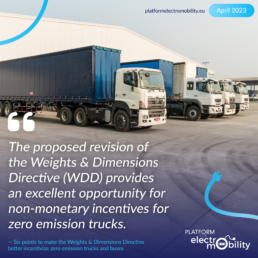
- Implement clear cross-border rules
As it stands now, the WDD enables the additional weight allowance only at border crossings of 13 EU Member States as the weight allowance only applies at borders of countries that have the lowest authorised vehicle weight. Furthermore, it does not provide an incentive for ZE HDV activities at the national level.
The current WDD has led to disputes between Member States on the allowed weight of HDVs on border crossings. In order to avoid any new disputes and remove the existing ones, the EC should develop rules that apply to the entire EU and not to selected border crossings.
The Benelux countries have done exactly that in 2022[3]. Although Benelux countries have different authorised weight allowances, when freight vehicles cross borders, the lowest weight limit in both countries is applicable. And for zero-emission vehicles, the additional weight allowance is automatically added.
Therefore, the European Commission should expand the scope of the WDD and clearly define that:
- The lowest authorised weight limit at border crossings is equal to the lowest authorised weight limit between two adjoining Member States;
- That the additional weight allowance for ZE HDVs is automatically added to the lower authorised weight limit;
- The additional weight allowance applies also for national transport.
- Modify the methodology governing the additional weight allowance
In practice, the current system requires the vehicle-maker to present a diesel comparator, with up to 2 additional tonnes then allowed above the weight of the comparator vehicle.
This system causes issues for new ZE vehicle-makers, which by definition, don’t have comparator vehicles to reference.
The WDD revision should grant some flexibility to new entrants by saying that the relevant authorities must have due regard to the position of new entrants in the selection and assessment of comparator vehicles.
- For long-range ZE trucks, permit one further tonne, linked to range, to a max of 3t
Up to ranges of approximately 400km, the additional 2t already granted is sufficient. Beyond this range, however, the allowance should be increased according to greater range provided. We suggest 2.5kg per km of ZE certified range above 400km to a maximum of 3t (i.e. the maximum is reached at 800km).
- Allow ZEHDVs a time-limited increase in the maximum authorised drive axle weight
The change most sought by truck and bus-makers is an increase in the maximum authorised axle weight placed on the axle connected to the zero emission powertrain, more commonly known as the drive axle. Today the weight limit applied to the drive axle is 11.5t, and due to the higher weight of ZE powertrains (e.g. batteries), truck and bus-makers ask that this limit be raised to 12t. This ask concerns two-axle tractor units and buses in the EU, which are the most-sold configurations.
On the one hand, such a change would boost the pace and scale at which zero-emission trucks and buses are deployed. On the other hand, without safeguards and phase-down dates, it could increase road wear.
Therefore, we advocate considering this change on the basis of a number of safeguards covering:
- tyre configuration and maintenance;
- the speed at which such vehicles can take off from a stopped position (“acceleration from rest”); and
- timeframe, namely that ZE truck & bus-makers can deploy 12t drive axles – under certain conditions – until a certain year (2029 for trucks).
Taking each of these in turn, for a qualifying vehicle, it would be necessary to deploy:
Tyres
- On the steer (front) axle, wide base high-efficiency tyres
- On the drive (rear) axle, dual tyre configuration (assembly) using high-efficiency tyres
- A Tyre Pressure Monitoring system that alerts the driver to a loss of pressure any greater than 0.5 bar, and with a duty to restore pressure to recommended levels at the nearest available facility having regard to the direction of travel
Acceleration limiter
- Ensuring take-off-from-rest is between 1 and 1.2m/s2
Timeframe
- 4×2 ZE trucks registered from entry into force [in ~2026] to 1.1.2029 can carry 12t on the drive axle – once the above conditions are met
- More flexibility on the end date could be considered for buses (and coaches) given their smaller sales numbers.
- European Modular System (EMS) should be zero-emission by 2028
There are calls across the trucking sector for more opportunities to use EMS. However, it can only be guaranteed that EMS will reduce emissions if the trucks are ZE. Therefore if proposals are made to permit cross border EMS, it can only be by ZE trucks, and where each route is checked and approved by the relevant authorities for road safety (i.e. that approach roads used to access the highway are suitable for EMS movement) and freight modality (coherence with overall freight policy goals).
- Set explicit time limits for WDD transposition and type-approval
The WDD does not have a formal time limit for transposing the existing 2 tonnes weight allowance into national law. This needs to be done as soon as possible as the business case for long-range zero emission HDVs depends on clear rules across Member States.
As the previous transposition of weights and dimensions rules to type approval law took four years, it is important to set a stricter deadline. This will enable manufacturers to achieve the recently proposed HDV CO2 reduction targets.
Ten truths about electric trucks and buses
Lice-cycle GHG emissions
Battery electric trucks have the lowest life-cycle GHG emissions
This is true from 16-40t trucks, according to a study by Ricardo Research (2020), which compared emissions of the differing drivetrain technologies based on a WTW approach. The emission-saving potential of electric vehicles (EVs) increase when entirely powered by renewable energy (up to 81%) compared to a fossil-powered alternative as shown by study ICCT (2021) undertaken in passenger cars. As battery-eletric trucks (BETs) have outstanding energy efficiency, lifecycle emissions decrease with every additional kilometre driven, meaning that long-distance trucks have particularly high emission-saving potential.
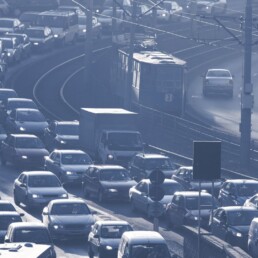

Energy efficiency
Battery electric trucks offer a dramatic improvement of energy efficiency
BETs offer a dramatic improvement of energy efficiency, i.e. the ability to drive a greater number of kilometres on the same amount of energy. The JRC, EUCAR and Concawe (2020) have updated their joint evaluation of the WTW energy use and Greenhouse gas (GHG) emissions for a wide range of powertrain options. Considering only zero-emission technologies on Wheel-to-Well (WTW) basis, BETs using green electricity - both regional and long-haul - are 2.6 times more energy efficient than the green hydrogen-powered fuel cell equivalent. Although synthetic fuels were evaluated for cars rather than trucks, as an indication a battery electric car using green electricity is 6.9 times more energy efficient than a combustion vehicle using e-fuel.
GHGs and air pollutant
Battery electric buses do not produce local GHGs and air pollutant emissions
Battery-electric buses (BEBs) do not produce local GHGs and air pollutant emissions, providing considerable health benefits, particularly in cities. Because they are powered by electricity, the higher powertrain efficiency means that BEBs emit 73% less CO2 equivalent than diesels, rising to 90% if powered by 100% renewable sources. In contrast (according to ICCT (2022)),Compressed Natural Gas (CNG) CO2 emissions are nearly 30% lower than a diesel, but its higher energy consumption - 24-50% per kilometre - reduces this advantage. In addition, methane is a potent GHG with a global warming potential more than 80 times greater than CO2 over a 20-year period; unintended leakages during extraction and transport further exacerbate the situation.
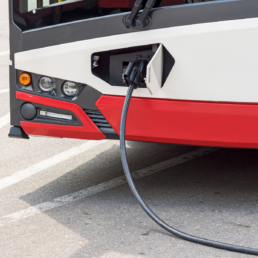

Intermodality
BETs will contribute to the further greening of intermodal transport
BETs will contribute to the further greening of intermodal transport, as well as improving the overall energy efficiency of freight logistics. Synergies between rail, road transport and inland waterways are crucial to the logistics system. These offer benefits for the whole supply chain, as intermodal transport helps reduce congestion in urban areas while potentially increasing capacity in and around cities. Tangible examples of intermodal links have been successfully deployed in Paris’ metropolitan area. Companies such as IKEA and Franprix supply stores in Paris are using a combination of electric ships and electric road transport solutions for the last-mile segment.
Electricity grid
With smart grid technologies, the grid would need little adaptation for BETs and BEBs.
With smart grid technologies, the grid would need little adaptation for BETs and BEBs. Uni- and bi-directional charging enables a double optimization of the load at the depot. Optimising the grid connection and allowing the monetisation of the vehicles' flexibility capabilities makes them valuable assets, even when parked: it also provides the grid with supplementary battery capacity. Vehicle-to-grid (V2G) is performed at much lower power levels than in regenerative braking or fast charging.
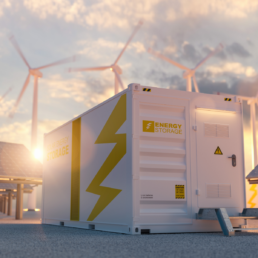

Cost
By 2030, 99.6% of new BETs will be cheaper to own and run than diesel trucks
By 2030, 99.6% of new BETs will be cheaper to own and run than diesel trucks while carrying the same weight of goods over the same distance and journey time, according to a study by TNO (2022). This study is based on the total cost of ownership (TCO), the most important economic indicator for a truck. It covers those deployed in urban and regional delivery over distances of 300 km as well as long-distance trucks travelling 800km/day. Due to the savings from using electricity rather than diesel, the cost-saving potential of BETs increases with every additional kilometre driven, meaning that by 2035, long-distance trucks will be the most cost-efficient solution in Europe.
Investment costs of battery elecric buses
Higher investment costs of BEBs offset by lower electricity consumption and maintenance costs.
Similarly, the higher investment costs of BEBs are offset by their lower electricity consumption and maintenance costs (in Spain and Latin America in 2021 and in Italy, US and UK by 2023). Bocconi University and Enel Foundation (2021) integrated well-known TCO (the initial investment in purchasing vehicles and the charging infrastructure, plus the operational and maintenance costs) with peculiar to BEBs circular economy revenue streams, by the second life of batteries and V2G. This explains why buses are now the fastest-growing zero-emission vehicle segment, making up 23% of new city buses in 2021, up from 16% in 2020. Considering the revenues from V2G and second life, BEBs are more cost effective than diesel and CNG buses.

Payload
Urban and regional trucks can already have as much payload capacity as their diesel counterparts
Urban and regional trucks can already have as much payload capacity as their diesel counterparts today, according to a recent study by TNO. While the battery of an electric long-haul truck currently may weigh several tonnes, depending on its size, the so-called 'ZEV weight allowance' grants an additional two tonnes to zero emission trucks on European roads. This, along with improving vehicle energy efficiency and battery energy density, will eliminate any payload loss by the end of the decade, even for long-distance trucks with 800km range.
Range
BETs already have more than sufficient range to cover freight transport routes in Europe
BETs already have more than sufficient range to cover freight transport routes in Europe, something that will continue to improve. With the compulsory 45-minute break every 4.5 hours, and given that they have a maximum permitted speed of 90km/h, trucks will never drive more than 400 km without having to stop. Tesla has begun deliveries of the ‘Tesla Semi’, a clean-sheet design BET with a real-world range of 800km when fully loaded. The EU’s Weights & Dimensions Directive allows ZETs to be increased by two tonnes over that of diesel trucks. This allowance alone already increases the payload-neutral range of electric trucks by over 300km.


Extreme conditions
BETs are as competent as diesel trucks in extreme cold.
BETs are as competent as diesel trucks in extreme cold. In February 2021, Volvo Trucks, ABB and Vattenfall - together with a local mining company - ran a trial on replacing the diesel transport of iron ore with BETs. The ore is taken from a North Sweden mine to the railway transfer station, in temperatures of -30C°. The BETs were used for the journey from the mine to the transfer station where they could unload the cargo while recharging batteries following a 280km round trip normally undertaken by diesel-powered vehicles. The Polar Winter Project proved the feasibility of electric transportation in extreme conditions. The BETs were able to drive the entire distance - including 140km with 14t of ore on board, at temperatures as low as -32C° - while taking the same amount of time as the diesel trucks.
BET Battery Electric Truck
GHG Greenhouse Gas
EV Electric Vehicle
WTW Wheel-to-Well
BEB Battery Electric Bus
CNG Compressed Natural Gas
V2G Vehicle-to-Grid
HDV Heavy-Duty Vehicle
LFP Lithium iron phosphate
TCO Total Cost of Ownership
ZEV Zero-Emission Vehicle
ZET Zero-Emission Truck
JRC Joint Research Center
Our Position Paper on the revision of the HDV CO2 emission standards
CO2 Standards for HDV
Our position ahead of Commission's proposal
The Platform for Electromobility strongly welcomes the revision of the CO2 standards for heavy-duty vehicles (HDV). The Platform sees the Regulation as a fundamental tool for electrifying trucks and thus advancing the zero emission transition within the road freight sector. Currently, this sector is responsible for 24% of the EU’s transport emissions, with trucks making up the largest part. The revision of HDV CO2 standards should align the CO2 targets for the sector with those of the EU’s overall 55% GHG reduction target in 2030 and the climate neutrality target of 2050.
In order to transition the road freight sector to zero emissions, more ambitious standards are needed to set the correct pace and a clear trajectory for manufacturers, logistics operators and for the supply chains in the electromobility and automotive industry. Scaling effects in production and technology development in the e-mobility and transport sector all contribute to making electric HDVs more competitive and widespread.
The Platform calls upon the European Commission to adopt the following recommendations as part of the revision of the HDV CO2 standards:
Strengthening the emission reduction targets to fully decarbonize the sector by 2050.
- Almost all newly registered HDVs (including long-haul) should be 100% zero emission by 2035 at the latest, given the average lifespan of a truck of approximately 15 years.
- An exemption should be considered for some niche vocational vehicles (such as those operating in remote areas or of abnormal weight) with a 100% Zero Emission Vehicle (ZEV) target by 2040, due to their more complex operational requirements and usually significantly lower mileage, which postpones the year of cost parity for the total cost-of-ownership for those vocational vehicles.
- The introduction of an intermediary CO2 target in 2027 of 30% for medium and heavy lorries is necessary to accelerate the transition to electric trucks during the 2020s.
- Strengthening the ambition of the 2030 CO2 target is crucial in providing momentum to, and further scaling up, the production and sales of ZETs. The 2030 target should be increased to an emission reduction level of at least 65%.
Extend the scope of the regulated HDV categories.
- Medium-sized lorries should be regulated through CO2 reduction targets, with the interim target of 30% in 2027 and the 2030 target of 65%.
- Small lorries – as well as urban buses and coaches – should have a mandated ZEV target, as they are not included in either the VECTO monitoring, or the datasets are deficient and hence have no CO2 reduction targets.
- The Platform recommends including small lorries with a ZEV target of 35% in 2027 and of 70% by 2030.
- Urban buses can decarbonise faster, and hence 100% of these should be ZEV by 2027. [1]
- Finally, coaches will transition a bit slower – due to the different vehicle design – with 20% ZEVs by 2027, 60% by 2030 and 100% by 2035.
- Trailers and semi-trailers will benefit from the introduction of energy efficiency targets, as this will unlock the deployment of zero-emission long-haul tractor-trailer combinations. The targets should be set where technically and practically feasible and as early as 2027. The full energy-efficiency potential of 12% for long-haul and 8% for regional delivery should be reached by 2030.
Other regulatory elements.
- The zero or low emissions vehicles (ZLEV) mechanism should be transformed into a ZEV-only mechanism with an enhanced benchmark of 15% by 2027. After 2030, the benchmark mechanism should be removed.
- The possibility of pooling of resources should be explored in the impact assessment, next to the introduction of a straight credit-trading scheme, which might allow for greater flexibility and less regulatory barriers.
- There should not be an exemption for small-volume manufacturers, as it risks creating a loophole for continuing to produce ICE-powered trucks.
- There should be no mechanism for renewable and low-carbon fuels to be included under this Regulation. Under such a mechanism, manufacturers could continue to produce ICE-powered trucks and delay the transition to ZEVs whilst not actually being able to control how fuels are ultimately being used (yet still being rewarded for it).
Ambitious charging infrastructure targets, as discussed in the Alternative Fuels Infrastructure Regulation (AFIR), are elementary for a successful rollout of ZETs. In addition, private as well as public investments will be needed to ensure higher grid capacity to serve the growing truck-charging demand. The revenues from excess emission premiums should be channelled back into the sector for the rollout of the infrastructure network. Related files, such as the Energy Performance of Buildings Directive (EPBD) can act an enabler for a smooth deployment of electric trucks. The platform therefore recommends including infrastructure requirements for charging at depots and logistic hubs.
Investing in the reskilling of workers is essential, both for those currently employed in HDV manufacturing and therefore see a conversion of current skills, and new ones who will be increasingly specialised in the new production value-chain. It can reduce social risk and increase workforce resiliency. Other measures such as job-search assistance for jobseekers and income and early retirement support could make the transition more just and fair.
The positive effects of electrifying heavy trucks are far-reaching, and go beyond reducing Europe’s GHG emissions; accelerating the zero-emission truck roll out also allows for drastic improvements to noise and air pollution. The high increase of energy efficiency in the case of battery-electric trucks is particularly beneficial when road transport accounts for 29% of the EU’s final energy consumption. The Platform for Electromobility also wishes to highlight that the transition to electric trucks and buses provides a considerable opportunity for the European e-mobility value chain and the competitiveness of the economy. Ambitious targets would make Europe a leader in zero emission HDVs and thus accelerate the unlocking of the potential of the e-mobility value chain.
[1] UITP is currently still considering its alignment with this objective.
First feedbacks to the revision of the CO2 emission performance standards for new heavy-duty vehicles
CO2 Standards for HDVs
Our first feedbacks to the Commission
The Platform for electromobility very much welcomes the Commission’s willingness to revise the HDV CO2 standards. The standards are a fundamental tool to advance the zero emission transition, as outlined in the European Green Deal and advance the transport sector. More ambitious standards set the right pace and a clear trajectory for manufacturers and logistics operators. Hence, the revision of the Directive (EC) 2019/1242 is a needed and welcome step of the Commission to lower emissions from trucks and other heavy-duty vehicles. The revision should align the CO2 targets for the transport sector with the EU’s overall -55% GHG reduction target in 2030 and the climate neutrality target of 2050. Importantly the HDV CO2 standards are the single most effective tool to achieve scaling effects in production and technology development, which contributes to making electric HDVs more competitive and widespread.
In particular, the Platform calls the European Commission to prioritise the following:
- Almost all newly registered heavy duty vehicles (including long haul) should be zero emission at the latest by 2035, whilst an exemption can be considered for some niche vocational vehicles (such as construction trucks) with a 100% ZEV target by 2040.
- The introduction of an intermediary target in 2027 is necessary to accelerate the transition to electric trucks already in the 2020s
- Strengthening the ambition in 2030 is crucial to spur the momentum and further scale up production and sales of ZETs.
- Crucially, no mechanism for renewable and low-carbon fuels should be included under this regulation
The Platform wants to stress that with regards to urban buses the revision of the CO2 standards should also take into account the demand-side targets from the Clean Vehicle Directive (Directive 2019/1161), especially when taking into account the purchasing of heavy-duty ZEVs for public authorities. The standards are an important tool to drive down the prices of buses of publicly procured vehicles, making them affordable for public institutions.
Lastly, the Platform highlights that the transition to electric trucks and buses is a considerable opportunity for the European electromobility value chain and the competitiveness of the economy. Ambitious targets would make Europe a leader in zero emission HDVs and thus further unlock the potential of the electromobility value chain.
Electrifying heavy trucks is particularly crucial in the wider context of reducing Europe’s GHG emissions as it makes up the largest part of the HDV emissions and allows to drastically improve noise and air pollution.
Investments need to be made for higher grid capacity to serve truck charging demand.
Our answer to the Revision of the Combined Transport Directive – Inception Impact Assessment
Combined Transport Directive
Our answer to the consultation
Directive 92/106/EEC is the only EU legal instrument directly targeting combined transport (CT), incentivising a more sustainable operational model for freight transport. Nearly thirty years later, the effectiveness of the Directive needs to be improved as the freight market and transport have gone through considerable changes. Furthermore, the political context has shifted as well, with an increased ambition on emissions-reduction objectives deriving from the European Green Deal and the Sustainable and Smart Mobility Strategy.
The Platform for Electromobility agrees with the European Commission that, without an intervention to promote the use of multimodal transport, the uptake of more sustainable transport options will not take place to the desired degree and in the desired time-frame to reach 2030 and 2050 EU objectives.
Strengthening combined transport fits perfectly into the vision of an integrated and sustainable comprehensive mobility system. The role of intermodal terminals, in this context, stands out through the optimisation of the connectivity of the different modes, and incorporating rail, roads and waterway systems into the freight logistics chain.
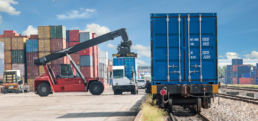
Among the options envisaged by the Inception Impact Assessment, Option 3 appears as setting the most effective way to crucially improve the framework for combined transport in Europe. The extension of the support from today’s narrowly defined combined transport operations to all intermodal or multimodal operations, and the categorisation of terminals based on infrastructure and operational efficiency – both proposed also under Option 2 – would broaden the Directive’s scope and streamline investments for combined transport’s infrastructures.
Moreover, Option 3 foresees an assessment of the efficiency of the measures to support the attainment of the objectives of the revised Combined Transport Directive. This measure would improve the reporting and monitoring conditions of the Directive.
Following this further, the Platform remains cautious about the viability of Option 4, which envisages mandatory harmonised support measures – such as a support to transhipment costs. Such proposal may open the door to state aid-related questions and be challenged across Member States.
The Platform for Electromobility looks forward to work with the European Commission to ensure that freight transport do not miss the decarbonization revolution and contributes efficiently to a sustainable, integrated and multimodal mobility system for Europe and set best practices for the world.
